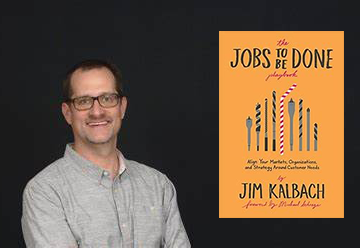Exclusive Interview for CustomerThink with Jim Kalbach
 The Jobs-to-be-Done (JTBD) approach offers a unique lens for viewing the people you serve. Instead of looking at the demographic and psychographic factors of consumption, JTBD focuses on what people seek to achieve in a given circumstance. People don’t “hire” products and services because of the demographic they belong to; instead, they employ solutions to get a job done.
The Jobs-to-be-Done (JTBD) approach offers a unique lens for viewing the people you serve. Instead of looking at the demographic and psychographic factors of consumption, JTBD focuses on what people seek to achieve in a given circumstance. People don’t “hire” products and services because of the demographic they belong to; instead, they employ solutions to get a job done.
JTBD is not about your product, service, or brand. Instead of focusing on your own solution, you must first understand what people want and why that’s important to them. Accordingly, JTBD deliberately avoids mention of particular solutions in order to first comprehend the process that people go through to solve a problem. Only then can a company align its offerings to meet people’s goals and needs.
I had the opportunity recently to interview Jim Kalbach, a noted author, speaker, and instructor in user experience design, information architecture, and strategy. He is currently Head of Customer Experience at MURAL, the leading online whiteboard. Jim has worked with large companies, such as eBay, Audi, Sony, Elsevier Science, LexisNexis, and Citrix. His latest book is The Jobs To Be Done Playbook.
Below is the text of the interview:
1. What is one of the biggest misconceptions people have about Jobs-to-be-Done (JTBD)?
There are a couple, actually.
First, I often hear others referring to JTBD as something “new.” It’s not. People have been working in the field for a couple of decades now. And precursors to modern JTBD go back nearly 40 years. We really just now see a surge of interest around JTBD, and the hype around it makes it feel new.
Second, JTBD often gets conflated with existing methods in other fields. Marketers look at it is as just another type of “voice of the customer” program. Or, folks coming from human-centered design and related fields see JTBD as a version of UX design or similar. While there might be some overlaps with existing disciplines, JTBD offers a unique perspective and yields unique insights.
Finally, I see JTBD as a “language” of sorts to describe the objectives and needs of the people you want to serve, and learning a language takes practice. Even people who “get” JTBD quickly need to put time into understanding the language and techniques, which at times can be specific and rigorous. I often see people expect to walk away from reading a book or taking a workshop fully capable of practicing JTBD. That’s rarely the case, and it typically takes some effort to work into the topic and apply it.
2. What are some of the benefits of taking a JTBD approach to innovation?
JTBD offers a unique perspective that points to new insights and opportunities. The JTBD approach intentionally forces us to expunge any mention of technology, solutions, brands, or methods from our language. In doing so, you’re able to then see your domain as people do. First and foremost, they want to get their job done, not necessarily interact with your product or service. Viewing objectives and outcomes people have independent of technology opens up new possibilities and yields new conversations that point toward innovation opportunities.
Also, but removing ourselves and technology from the equation, we can better future-proof our thinking. Solutions come and go. Technology is often a fad. Jobs, on the other hand, are stable when you boil them down to their fundamental steps.
3. Who needs to be considered after selecting a job to focus on?
At first, simply consider job performers. Once you’ve defined your target job, you first want to understand how the job gets done independently of any specific technology or solution. I find that different types of job performers emerge based on the key factors, or circumstances, of getting the job done that can give rise to different personas.
Within your team, I recommending going as broad as possible and including stakeholders at all levels. Yes, JTBD can help you find hidden needs to address. But it’s also a catalyst for conversations and a way to get team alignment. Think of the various ways you can involve others in everything from the definition of your jobs landscape to interviews with job performers to creating a job map to finding opportunities.
4. What is your perspective on the interrelationship between functional, social and emotional jobs within JTBD?
I find that functional jobs give the most structure and reliability to work with initiation. So your work is generally framed by functional jobs, with emotional and social aspects layered on top. Emotional and social aspect then play a larger role when finding solutions to the unmet needs you’ve found and help frame how you’ll solve for them.
Continue reading the interview on CustomerThink

![]() Sign up here to get Human-Centered Change & Innovation Weekly delivered to your inbox every week.
Sign up here to get Human-Centered Change & Innovation Weekly delivered to your inbox every week.